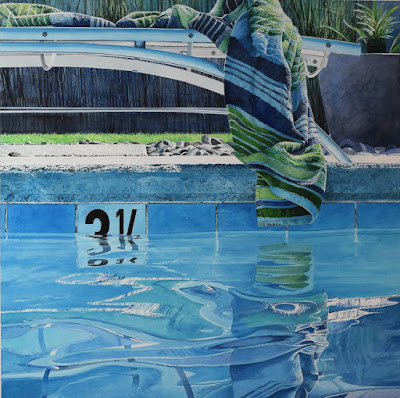ARTIST PROFILE: Doug Shoemaker
Doug Shoemaker was once told by the East Coast watercolor painter Howard Etter to “draw what [he saw].” And over his decades-long career as a watercolorist and architect, Shoemaker has done just that, creating indelible, precise images of urban and suburban scenes, often with a focus on the elegance of simple city and residential architecture. Working in a realist idiom, Shoemaker depicts abandoned streets and buildings with a combination of tranquility and tension, enhanced by his choice of palette, use of chiaroscuro, and line, reminiscent of Edward Hopper. Based in San Francisco, Shoemaker credits the city as a source of inspiration for his work, citing the city’s light, fog, and architecture in particular: “The light in San Francisco is special […] it always came across very white, very cool and filtered, perhaps from our fog that constantly drifts in and out of our daily lives […] I became strongly aware of the [city’s] architecture because of the way it always seemed to push against you with buildings at the very edge of sidewalks; one is unable to look away or not be aware of details, colors and textures at such a close vantage point.”
"Poolside I," watercolor on paper, 36" x 36"
Trained as an architect at Lawrence Technological University, Shoemaker furthered his nascent interests in painting and drawing en plein air at the Cranbrook Academy and in intaglio printmaking at the Fort Mason Art Center in San Francisco. While not a practicing architect now, Shoemaker acknowledges the effects the discipline has had on his practice engaging with two-dimensional media: “I think my background as an architect and becoming one has had a major influence on my work in watercolor painting. Architects spend a great deal of time learning structure, form, composition, balance, texture and color. All of those elements are present in my paintings in some form, often becoming a tightly composed fragment of a much larger part of the image.” Watercolor came naturally to him, as he finds the simple set of tools easy to use, and since starting out on a smaller scale with still-life works, Shoemaker has been gradually working up towards creating monumental watercolor paintings.
While Shoemaker chooses not to depict people in his paintings, he is far from unconcerned with the idea of the human element, representing the people of San Francisco and other locales with their traces in his series Pools and Lounges: ripples in a pool’s surface, the just-arranged folds of a towel, the elasticity of a shadow. Says Shoemaker: “By eliminating any figurative element, I am attempting to express a kind of stillness, a quietude, a Zen sense of alone-ness that may offer a respite from the over-hyped, over-expressed, over-shared society we now live in.”
"Queen Valley Road," watercolor, 8" x 10"
A turning point came in Shoemaker’s career when he was selected as a Joshua Tree National Park Artist-in-Residence in the spring of 2015; he eagerly accepted the personal challenge of applying his technique to representing rural environs rather than his usual cities or backyards. While Shoemaker’s usual approach involves careful, exact reproductions done in his studio based on photographs, painting the picturesque wilderness of Joshua Tree required a “[loosening] up,” as he puts it, a distillation of the key aspects of his style: attention to light and shadow, tightly edited compositions, and a renewed emphasis on texture. The resulting series, titled Rock/Sky Juxtaposition, delights in the irregular forms of the national park’s bodies of water and rock formations and the intersection of the two, recalling a milder take on the classic Winslow Homer aesthetic.
Shoemaker is not shy about recognizing the various artists who have influenced his practice, naming his high school art teacher Mrs. Pat Thwing along with the late architect Patrick McGrew, California painter Robert Bechtle, and museum staples such as Andrew Wyeth, Richard Diebenkorn, and John Singer Sargent. When asked what he wants his body of work to convey to viewers, Shoemaker says, “I hope that the viewer might gain an appreciation for what I call ‘ordinary places with meaning.’ Maybe my work will cause them to slow down next time and take a second look at that shadow crossing a wall, the purity of the architecture in that abandoned gas station against the open desert sky, the randomness and texture of that pool towel stretched lazily across the lounge, the plain garage doors etched in the morning sunlight […] I hope they take away a new appreciation for the beautiful and simple medium of watercolor painting. I especially enjoy it when a viewer comments to me that they had no idea 'it was a watercolor painting.' I’m hoping to raise the awareness of what watercolor can do and how far it can go as a strong and powerful medium. I’m hoping the viewer can see where the 'ordinary becomes complex, memorable and poetic.'"
"San Diego Blue," watercolor, 16" x 16", 2013



Comments
Post a Comment